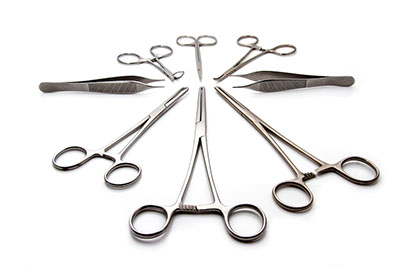
Forcep is a handheld, hinged instrument used for grasping and holding objects. A forcep is used when fingers are too large to grasp small objects or when many objects need to be held at one time while the hands are used to perform a task. It is also used to hold slippery objects or for aseptic purposes.
Mechanically, forceps employ the principle of the lever to grasp and apply pressure.
Surgical forceps are commonly made of high-grade carbon steel. Lower quality steel is used in forceps made for other uses. High carbon steel ensure that the instruments can withstand repeated sterilization in high-temperature autoclaves. Some forceps, intended to be used once and then discarded, are made of plastic.
There are two basic types of forceps: non-locking (often called 'thumb forceps' or 'Pick-ups') and locking, though these two types come in dozens of specialized forms for various uses. Non-locking forceps also come in two basic forms, hinged at one end, away from the grasping end and hinged in the middle, rather like scissors (though, unlike scissors, forceps meet on flat, grasping surfaces rather than in interposing blades). Locking forceps are almost always hinged in the middle, though some forms place the hinge very close to the grasping end. Locking forceps use various means to lock the grasping surfaces in a closed position to facilitate manipulation or to independently clamp, grasp or hold an object.
Thumb forceps

Thumb forceps are commonly held between the thumb and two or three fingers of one hand, with the top end resting on the anatomical snuff box at the base of the thumb and index finger. Spring tension at one end holds the grasping ends apart until pressure is applied. This allows one to quickly and easily grasp small objects or tissue to move and release it or to grasp and hold tissue with easily variable pressure. Thumb forceps are used to hold tissue in place when applying sutures, to gently move tissues out of the way during exploratory surgery and to move dressings or draping without using the hands or fingers.
Thumb forceps can have smooth tips, cross-hatched tips or serrated tips (often called "mouse's teeth" or "rat's teeth"). Common arrangements of teeth are 1x2 (two teeth on one side meshing with a single tooth on the other), 7x7 and 9x9. Serrated forceps are used on tissue; counter-intuitively, teeth will damage tissue less than a smooth surface (you can grasp with less overall pressure). Smooth or cross-hatched forceps are used to move dressings, remove sutures and similar tasks.
Locking forceps
Locking forceps, sometimes called clamps, are used to grasp and hold objects or tissue. When they are used to compress an artery to forestall bleeding they are called hemostats. Another form of locking forceps is the needle holder, used to guide a suturing needle through tissue. Many locking forceps use finger loops to facilitate handling. The finger loops are usually grasped by the thumb and middle or ring fingers, while the index finger helps guide the instrument.
The most common locking mechanism is a series of interlocking teeth located near the finger loops. As the forceps are closed, the teeth engage and keep the instrument's grasping surfaces from separating. A simple shift of the fingers is all that is needed to disengage the teeth and allow the grasping ends to move apart. Forceps are also used for surgery.
Kelly Forceps
Kelly forceps (also known as Mosquito or Rochester forceps) are a type of hemostat usually made of stainless steel. They resemble a pair of scissors with the blade replaced by a blunted grip. They also feature a locking mechanism to allow them to act as clamps. Kelly hemostats are distinguished from the crile variety, in part, by their cross-hatched grip pattern, as opposed to a simple system of grooves. Kelly forceps may be floor grade (regular use) and as such not used for surgery. It may also be sterilized and used in operations. They may be either curved or straight. In surgery, they may be used for holding off blood vessels or tissues, as general purpose clamps, or for assorted other purposes. The "Mosquito" variant of the tool is more delicate and have smaller, finer tips. A similar tool is the Carmalt, which is heavier and longer.
Medical forceps
Here are few categories that are commonly used:
- Alligator forceps
- Anesthesia forceps
- Artery forceps
- Atraumatic forceps
- Biopsy forceps
- Bone-cutting forceps
- Bone-holding forceps
- Bone-reduction forceps
- Bulldogs forceps
- Catheter forceps
- Cilia forceps
- Curettes forceps
- Cushing forceps
- Dermal forceps & nippers
- Dressing forceps
- Ear forceps
- Eye forceps
- Gallbladder forceps
- Gerald forceps
- Harvey forceps
- Hemostatic forceps
- Hysterectomy forceps
- Intestinal forceps
- Magill forceps
- Microsurgery forceps
- Nasal forceps
- Obstetrical forceps
- Postmortem forceps
- Splinter forceps
- Sponge forceps
- Spreading forceps
- Sterilizer forceps
- Suture sundries forceps
- Tenaculum forceps
- Thoracic forceps
- Thoracic surgical forceps
- Thumb forceps
- Tissue forceps
- Tongue forceps
- Tooth extracting forceps
- Tubing forceps
- Uterine forceps
- Vulsellum forceps
- Wire cutting forceps
Uses
For grasping and holding objects.
